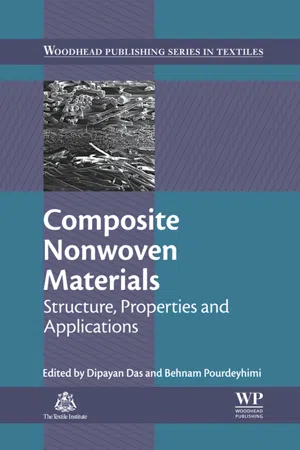
Composite Nonwoven Materials
Structure, Properties and Applications
- 252 pages
- English
- ePUB (mobile friendly)
- Available on iOS & Android
About This Book
Composite nonwoven materials are versatile materials with a variety of applications, including hygiene, medicine and filtration. This important book provides a technical resource for professionals and academics in the field. It explores these materials in terms of fiber types used, manufacturing processes, structure, and physical properties.
The first part of the book focuses on the use of natural and synthetic fibers in composite nonwovens, discusses their structure in terms of fiber packing and alignment, and their physical properties. Further chapters deal with the practical applications of composite nonwoven materials. Hygiene applications, such as diapers, female sanitary products, incontinence pads, and wipes are covered, as well as composite nonwoven-based medical products and filters.
Composite Nonwoven Materials is an ideal reference for R&D managers in the textile industry and academic researchers in textile science.
- Systematic and comprehensive information on composite nonwovens
- Critical review of progress in research and development on composite nonwovens
- Comment on future research direction and ideas for product development
Frequently asked questions
Information
Introduction to composite nonwovens
Abstract:
1.1 Introduction
1.1.1 Definitions of composite
1.1.2 Definitions of nonwoven
1.1.3 Definitions of composite nonwoven
Table of contents
- Cover image
- Title page
- Table of Contents
- Copyright
- Contributor contact details
- Woodhead Publishing Series in Textiles
- Chapter 1: Introduction to composite nonwovens
- Chapter 2: Natural and synthetic fibres for composite nonwovens
- Chapter 3: Structure of composite nonwovens
- Chapter 4: Properties of composite nonwovens
- Chapter 5: Composite nonwovens in absorbent hygiene products
- Chapter 6: Composite nonwovens in wipes
- Chapter 7: Composite nonwovens in filters: theory
- Chapter 8: Composite nonwovens in filters: applications
- Chapter 9: Composite nonwovens in medical applications
- Index